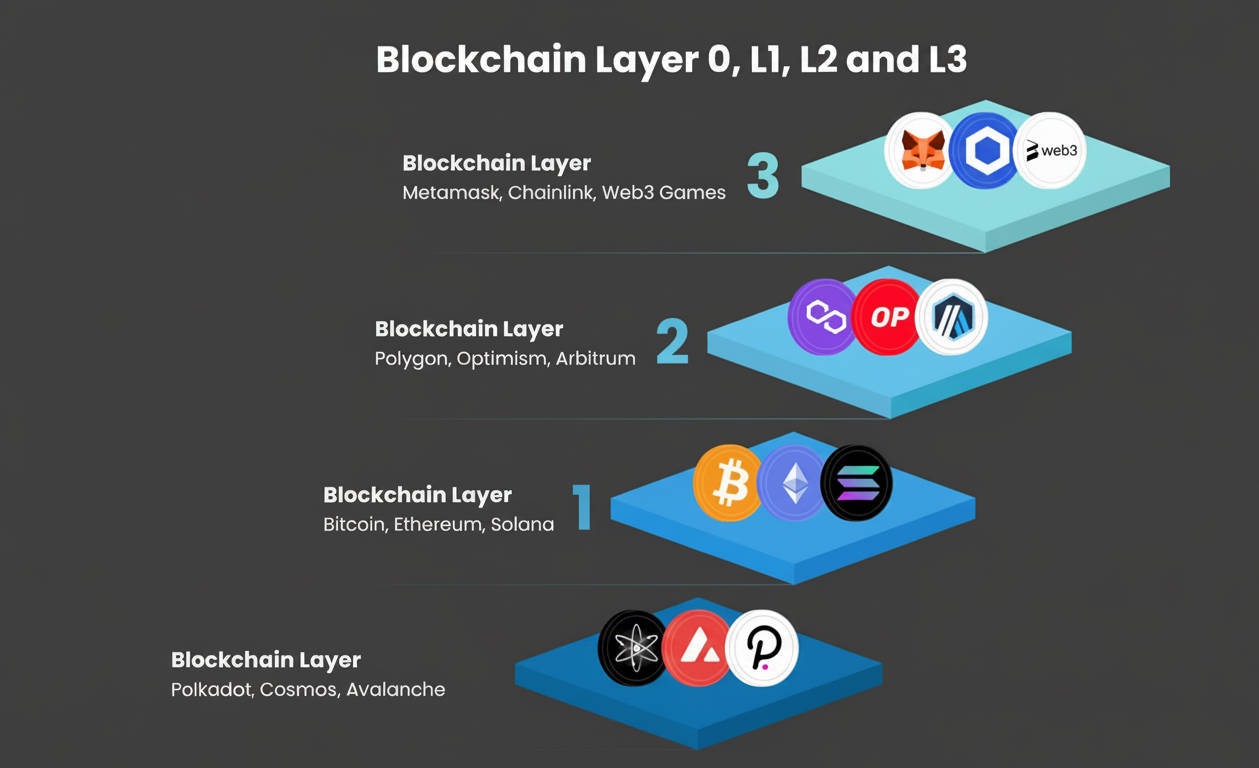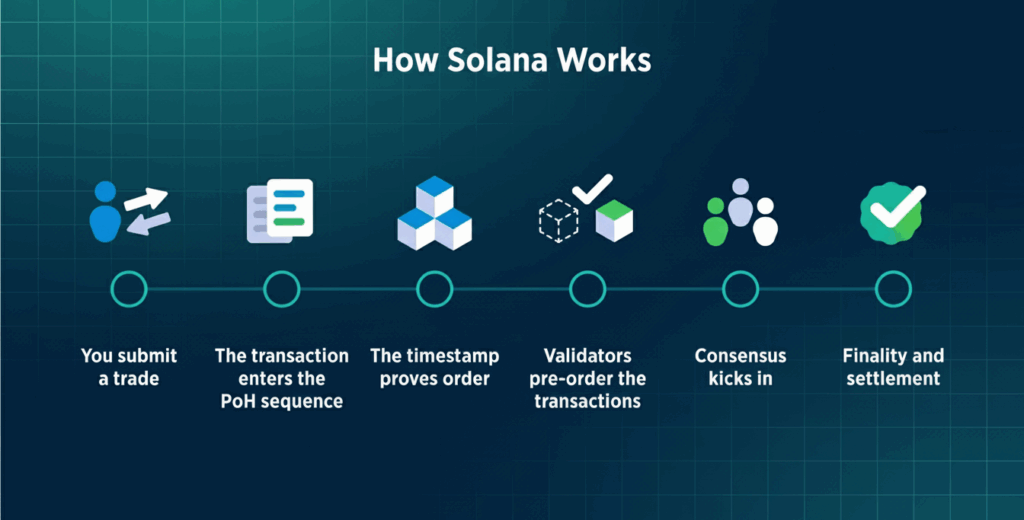In the ever-evolving world of blockchain, Solana has emerged as one of the most promising and practical platforms available today. Known for its incredible speed, low transaction costs, and developer-friendly design, Solana is increasingly seen as a serious alternative to more established networks like Ethereum.
Built to power the next generation of decentralized applications (dApps), Solana provides a highly scalable and energy-efficient infrastructure that can handle real-world demand, whether for trading, payments, NFTs, gaming, or financial tools.
Solana Is a Layer 1 Blockchain
Solana is a Layer 1 blockchain, meaning it operates as a standalone base network and doesn’t rely on any other blockchain to function. It handles transaction execution, security, and data storage all on its own infrastructure.
In contrast to Layer 2 solutions, which are built on top of existing chains like Ethereum to increase scalability, Solana was designed from the ground up to be natively fast and scalable. This makes it more efficient, with no need for add-on layers or extra processing hubs.

Key traits of Solana as a Layer 1:
- Independent network with its own consensus system
- No reliance on Ethereum or Bitcoin
- Handles smart contracts, tokens, and dApps directly
- No Layer 2 scaling required for high performance
How Solana Works: Proof of History + Proof of Stake
Solana’s performance is made possible by its innovative consensus mechanism, which combines Proof of History (PoH) and Proof of Stake (PoS). Together, these technologies allow Solana to process thousands of transactions per second without sacrificing security.
Proof of History is Solana’s most unique feature. It acts as a cryptographic timestamping system that records the order of transactions before consensus. This significantly reduces the work validators need to do, speeding up the process.

Meanwhile, Proof of Stake selects validators based on the amount of SOL tokens they stake on the network. Validators confirm transactions and receive rewards, helping to secure the network in an energy-efficient way.
Combined, this system allows Solana to:
- Confirm transactions in under a second
- Process thousands of transactions simultaneously
- Reduce bottlenecks that slow other chains
- Maintain decentralization through globally distributed validators
Speed, Cost, and Performance
One of Solana’s biggest advantages is its raw speed and low cost. The network was built for high performance and has delivered impressive real-world results.
Solana’s network performance (as of 2025):
- Average block time: 400 milliseconds
- Live transactions per second (TPS): Over 3,000
- Theoretical TPS capacity: Up to 65,000
- Average transaction cost: $0.00025
- Energy use per transaction: Equivalent to a few Google searches
- Carbon footprint: Net-zero through offset partnerships
This level of performance allows Solana to support micropayments, high-frequency trading, and real-time user experiences that would be costly or slow on other blockchains.
What Is SOL?
SOL is the native token of the Solana blockchain. It’s used across the network to:
- Pay transaction and smart contract fees
- Stake and secure the network
- Participate in governance (voting on proposals)
- Interact with dApps and services on Solana
Like ETH on Ethereum or BTC on Bitcoin, SOL powers the entire ecosystem.
Solana uses a deflationary mechanism where a portion of each transaction fee is burned, permanently removing those tokens from circulation. This helps balance the network’s inflationary rewards and protect long-term value.
SOL tokenomics:
- Max supply: ∞
- Circulating supply: 449 million
- Burn mechanism: Part of every fee is destroyed
- Staking: Earn rewards by locking SOL with a validator
Solana’s Token Standard: SPL
Solana has its own token standard called SPL (Solana Program Library). It serves the same function as Ethereum’s ERC-20 (for cryptocurrencies) and ERC-721 (for NFTs).
SPL tokens allow users to:
- Create and manage fungible tokens (e.g., USDC, BONK)
- Mint NFTs (non-fungible tokens) like digital art or collectibles
- Launch their own projects or community tokens
- Trade and swap tokens instantly within the ecosystem
Most assets on Solana, including stablecoins, NFTs, and memecoins, are built using this SPL format.
Use Cases: What You Can Do on Solana
Solana supports a wide range of real-world and digital use cases, thanks to its speed, scalability, and cost-efficiency.
Common things you can do:
- Send money globally in seconds
- Swap tokens instantly using DeFi apps like Jupiter
- Buy and sell NFTs on platforms like Magic Eden
- Play blockchain-based games with real asset ownership
- Stake SOL and earn rewards
- Join DAOs or participate in on-chain voting
- Invest in tokenized real estate via apps like Homebase
- Pay with USDC at merchants via Solana Pay (e.g., Shopify stores)
Solana makes these experiences feel like using normal apps fast, smooth, and low-cost, which is essential for mainstream adoption.
Smart Contracts and Sealevel
Solana allows developers to build powerful applications using on-chain smart contracts written in Rust, C, or C++, not Solidity.
Because Solana is not EVM-compatible, developers can’t just copy Ethereum contracts. However, Solana offers Sealevel, a unique transaction engine that enables parallel smart contract execution.
Why this matters:
- Apps run faster and smoothly
- Multiple transactions can be processed at once
- Developers can create complex apps without traffic jams
- More efficient than Ethereum’s single-threaded execution
This is why many high-performance apps, especially games and DeFi tools, are choosing Solana.
Real-World Metrics and Growth
Solana isn’t just promising on paper; it’s delivering in practice.
As of 2025:
- Fee-paying accounts (all-time): Over 29.7 million
- NFTs minted: Over 340 million
- Median transaction fee: ~$0.00064
- Validator nodes: 2000 – 3000+ active
- Total transactions: Over 410 billion
These numbers reflect real, ongoing usage, not just speculation.
Solana Goes Mobile: The Saga Phone
Launched in 2023, the Solana Saga smartphone marked Solana Labs’ push into Web3 mobile innovation through the Solana Mobile Stack (SMS). Designed for crypto-native users, it integrated blockchain tools directly into the mobile experience.
Key features include:
- A secure hardware wallet (Seed Vault) for private key storage.
- A custom dApp store without Apple or Google restrictions.
- Built-in access to SOL, NFTs, and token management.
- Support for Solana Pay and other DeFi applications.
The Saga aimed to drive mass adoption of decentralized apps, especially in mobile-first regions. However, its lifecycle will end two years after launch, with the final update in November 2024 and full support ending around October 2025. Solana Mobile is now focusing on its next-generation device, the Solana Seeker, redirecting development and support toward that model.
Security, Validators, and Decentralization
Solana is secured by a global network of validators who process transactions and maintain the blockchain. These validators stake SOL to help secure the network and earn rewards.
While Solana is decentralized, it is less decentralized than Ethereum due to the hardware requirements to run a validator node.
Validator Facts:
- 2000 – 3000+ validator nodes worldwide
- Requires powerful hardware to participate
- Validators are rewarded with newly issued SOL and fees
- Solana Foundation is working to reduce hardware entry barriers
Although it may seem more centralized than Ethereum, Solana remains censorship-resistant and secure, with active development to make it more accessible.
Network Outages and Improvements
Solana has experienced network outages in the past. These incidents, often caused by spam, bugs, or traffic surges, raised concerns about reliability.
Notable outages include:
- A 17-hour outage in 2022
- A 5-hour outage in February 2024
- Congestion during major memecoin launches (March 2025)
In response, Solana’s core developers have implemented:
- Traffic flow control tools
- Validator performance updates
- Quicker response mechanisms and software upgrades
Since early 2024, network reliability has improved significantly, and outages have become less frequent.
Stablecoins and Payments on Solana
Solana supports native versions of major stablecoins, which play a huge role in DeFi and payments.
Popular stablecoins on Solana:
These stablecoins enable real-time payments, especially through Solana Pay, which allows merchants (like those on Shopify) to accept instant USDC payments with near-zero fees.
Developer Ecosystem and Community
Solana is home to one of the most active and growing developer communities in Web3.
Developer Highlights:
- Over 48,000 developers participated in Solana hackathons
- Strong support from the Solana Foundation through grants and tools
- Massive events like Solana Breakpoint and Hacker Houses
- Monthly deployment of 2,000+ active programs
With its Rust-based programming, fast execution, and low fees, Solana appeals to both new blockchain developers and experienced software engineers.
Solana’s Growing Strength
Solana has built a solid foundation for real-world blockchain applications. With innovations like Proof of History, the Sealevel execution engine, and a growing list of use cases, Solana is shaping up to be one of the most practical and user-ready Layer 1 blockchains available today.
It may not be perfect, with decentralization and reliability challenges still being improved, but its focus on speed, affordability, and usability puts it in a strong position for continued adoption in the years ahead.


